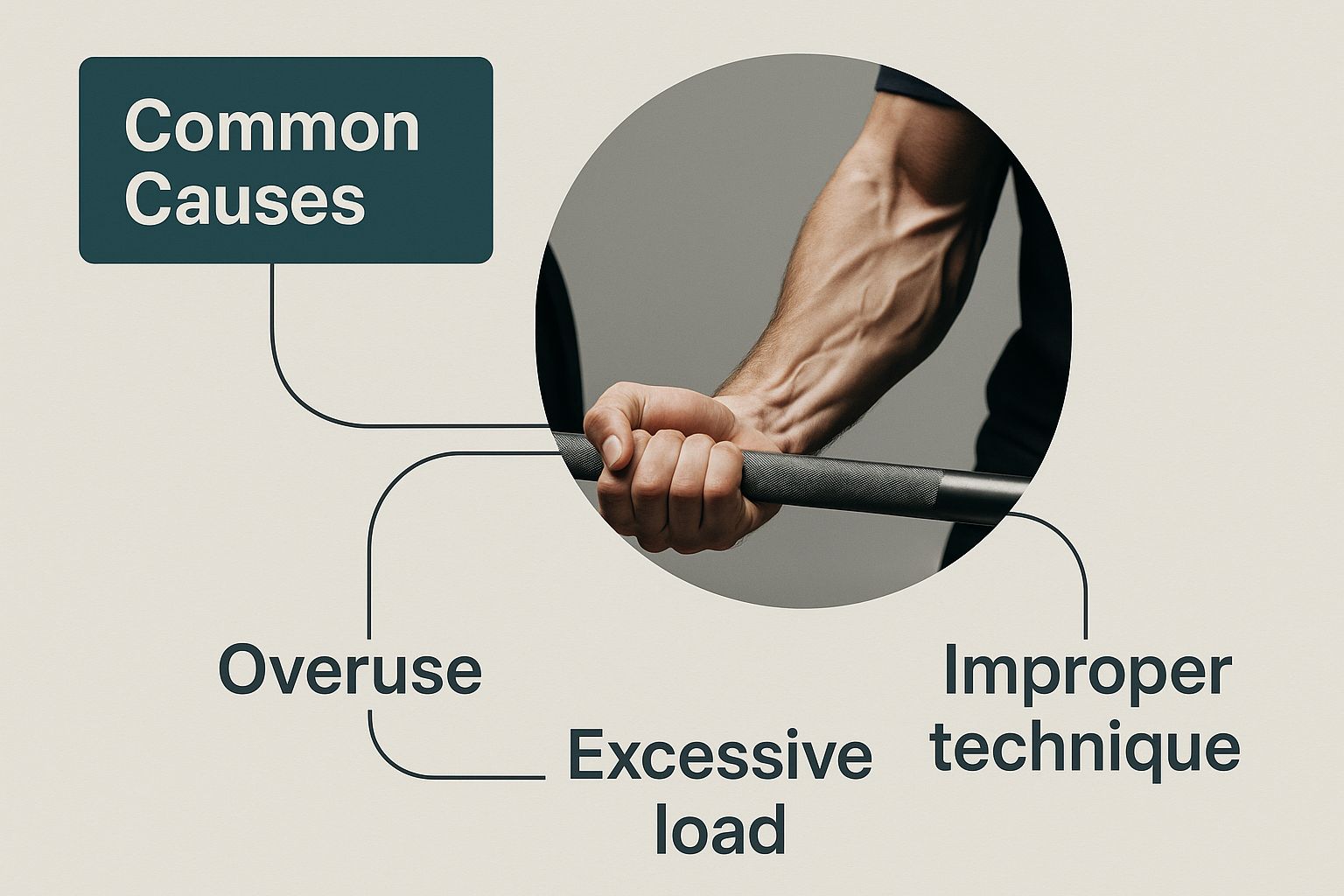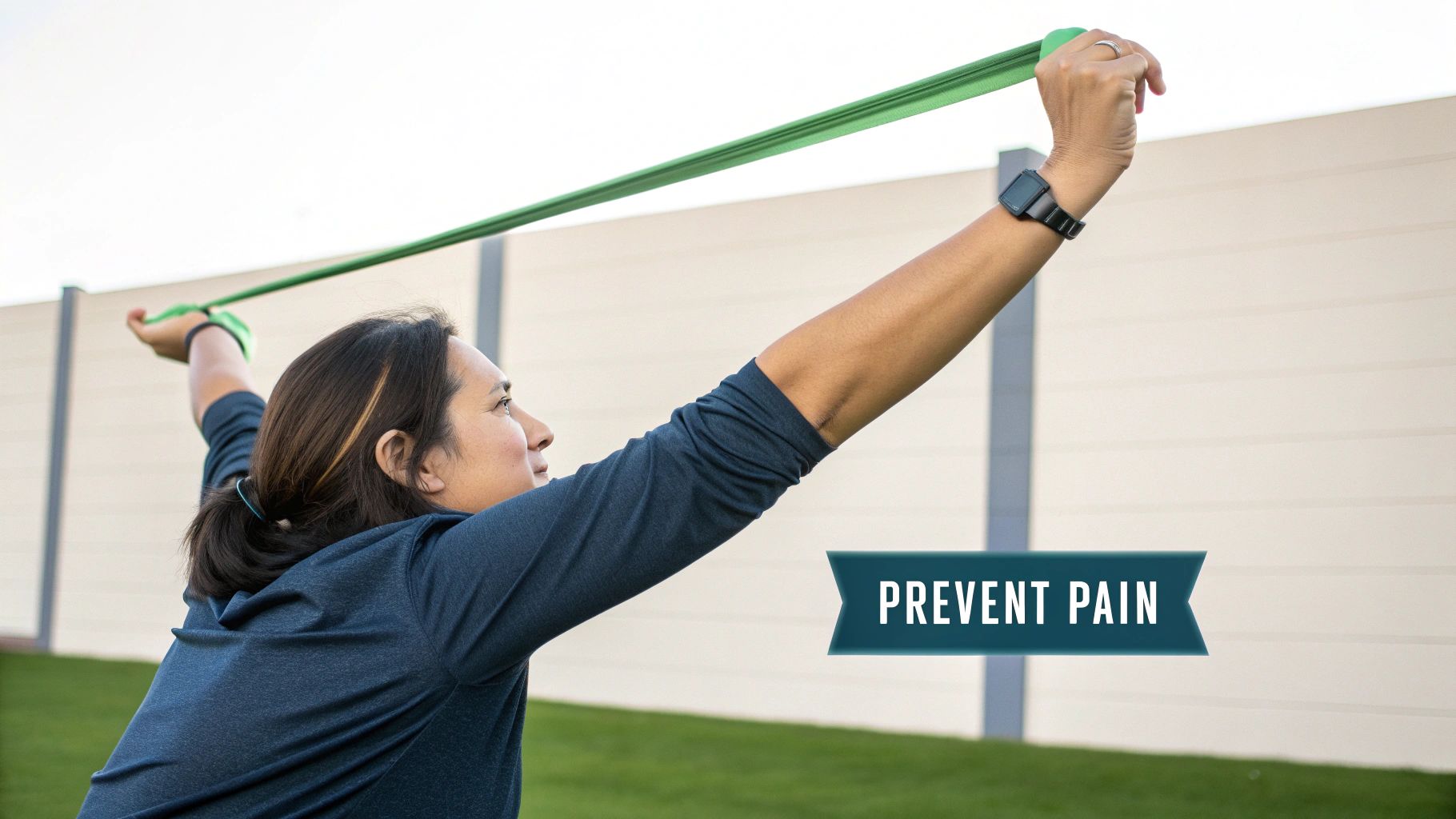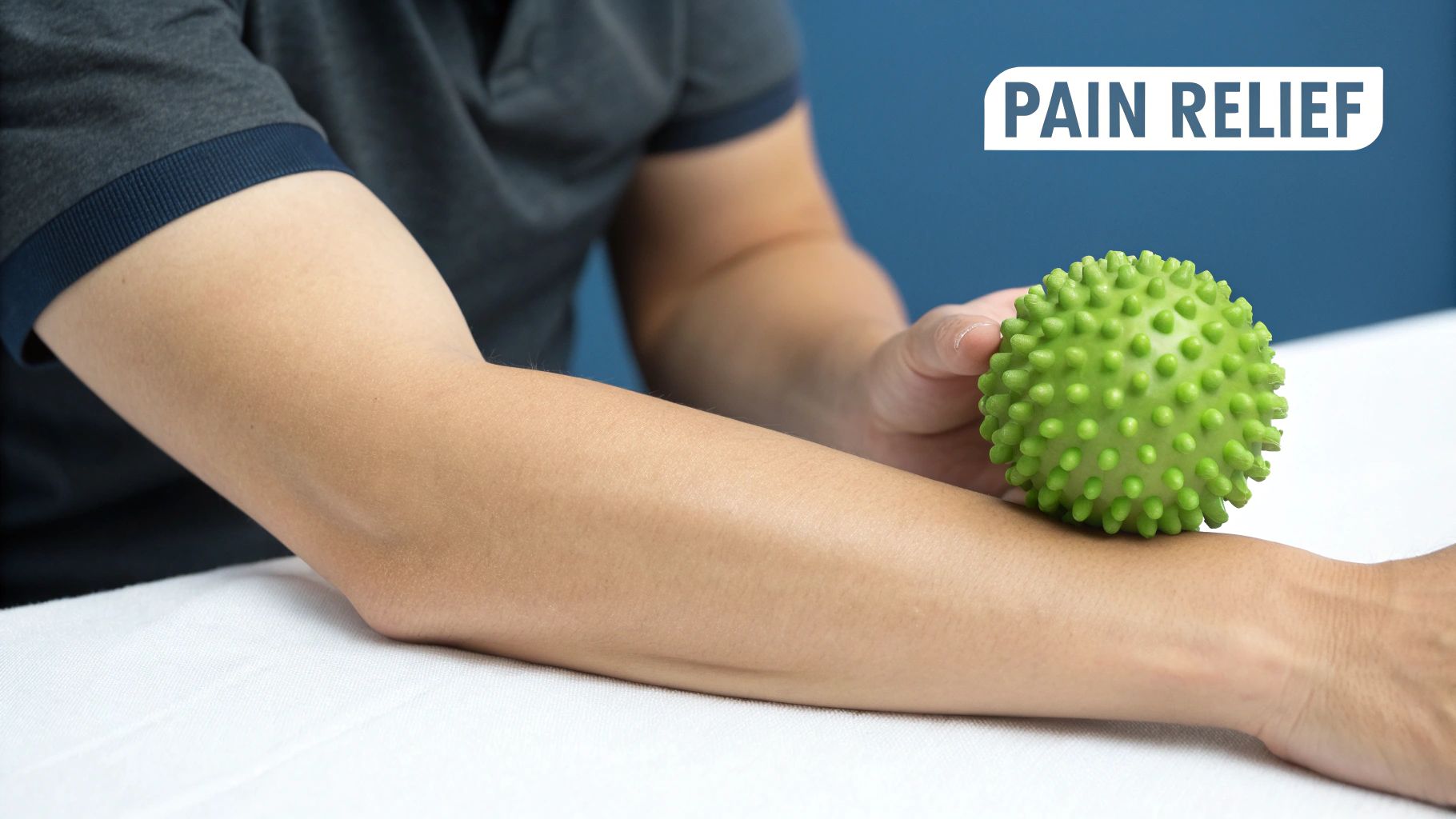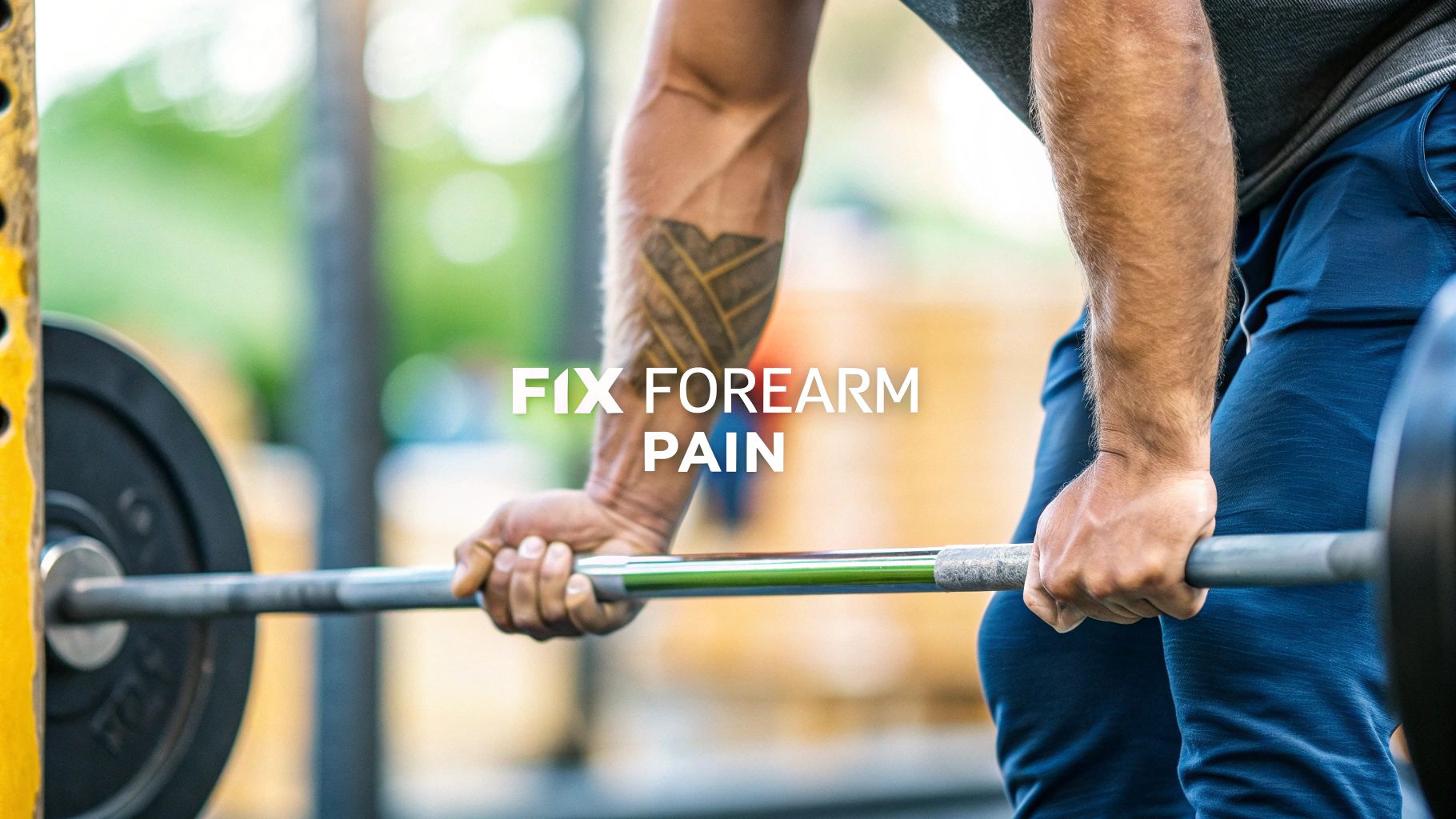.webp)
That sharp, burning sensation in your forearm isn't just a sign you’ve had a tough workout. Think of it as a warning light on your body’s dashboard. Forearm pain when lifting is often your muscles and tendons telling you they’re being overstressed from poor form, a weak grip, or simply pushing things too hard, too soon. Getting to the root of that signal is the first step back to pain-free training.
Imagine the tendons in your forearm are like a thick rope. With smooth, controlled movements, that rope can handle incredible tension. But if you suddenly yank it, overload it with too much weight, or repeatedly rub it against a sharp edge, its fibres will begin to fray. That "fraying" is essentially what's happening inside your forearm when its structures are pushed beyond their limits, leading to inflammation and pain.
This isn’t just an issue for gym-goers; it’s a problem that shows up in the workplace, too. Upper limb disorders, which include many of the conditions causing forearm pain, accounted for a staggering 43% of the 9.466 million working days lost to musculoskeletal problems in Great Britain. Repetitive strain is a massive issue, whether you’re lifting a barbell or typing at a desk all day.
So, what’s causing that specific pain in your forearm? It usually comes down to a few common culprits that put too much stress on those "ropes." Nailing down the cause is key to finding a fix that actually works.
The main reasons for your discomfort often include:
The pain you feel is a direct message. It’s not a sign of weakness, but a clear indicator that your technique, volume, or recovery needs a rethink to protect your joints and tendons for the long haul.
It's also worth thinking about how your daily habits contribute. A poor ergonomic setup at your desk can leave your wrists and forearms weak and tight, making them far more likely to get injured during a workout. You might find an ergonomic assessment can highlight issues in your daily routine that are making the problem worse.
Not all forearm pain is the same. The location and type of discomfort can give you big clues about what’s going on under the skin. Use this table as a starting point to help identify the potential cause.
Remember, this is just a guide. If your pain is severe, persistent, or accompanied by significant weakness, it’s always best to get a professional diagnosis.
To get a proper grip on forearm pain, you first need to know what’s going on under the skin. Your forearm isn't just one big muscle; think of it more like a sophisticated bit of machinery, full of pulleys and levers all working in sync to control your wrist, hand, and most importantly, your grip. This is the system that lets you clutch a heavy barbell or finely control a dumbbell.
At its core, your forearm has two main muscle groups doing the heavy lifting. On the inside (the palm side), you’ve got your flexor muscles. These are the ones that curl your wrist and clench your fist—they’re the absolute powerhouse behind your grip strength. On the top, you have the extensor muscles, which do the exact opposite, opening your hand and bending your wrist back.
Connecting these muscles to your fingers and hand are tendons, which are like tough, fibrous cables. They transmit all the force your muscles generate into actual movement. When you lift, this entire system goes under a huge amount of tension.
Every single time you pick up a weight, this system fires up. Bicep curls, pull-ups, even something as simple as a bench press—they all rely on your forearms to stabilise the weight and keep your grip from failing.
Take the humble bicep curl. As you lift that dumbbell, your flexor muscles are working overtime to keep your hand wrapped tight around the handle. At the same time, your extensors are fighting to keep your wrist straight and prevent it from collapsing under the load. It’s a finely tuned balancing act. If one part of the system is overworked, or just plain weaker than the other, the strain gets distributed unevenly. And that’s usually where the trouble starts.
The image below breaks down the common culprits that throw this balance out of whack, leading to that all-too-familiar ache.

As you can see, things like overuse, bad technique, and muscle imbalances are the main reasons a good lift turns into a painful one.
Getting your head around this relationship between muscles and tendons is so important. The pain you're feeling isn't random; it's a direct signal that something in this mechanical chain has broken down.
For example, if your grip is the weak link in your deadlift, your forearm flexors will go into overdrive trying to compensate. This puts a massive amount of repetitive strain on the tendons near your inner elbow. Do that for long enough, and you’ll get the classic symptoms of "Golfer's Elbow"—even if you’ve never set foot on a golf course.
With this knowledge, you can start to think more critically about your form. You can visualise which parts of your forearm are taking the strain during a particular lift and tweak your technique to protect them. It’s about shifting from just moving weight to understanding the how and why behind the movement. That’s the real key to building strong, resilient, and pain-free forearms for the long run.
https://www.youtube.com/embed/PTFBQYxAi_U
That dull ache or sharp sting you feel isn't just "soreness." It's a clear signal from your body that something in your lifting technique is overloading the delicate muscles and tendons in your forearms. Let’s get past the complicated medical jargon and look at the real-world movements that are actually causing the problem.
More often than not, the issue boils down to a simple overuse injury. You’ve probably heard of Tennis Elbow and Golfer’s Elbow. Despite the names, these are just terms for tendon inflammation—either on the outside or inside of your elbow—and they’re almost always caused by repetitive stress. The kind of stress you create with every single rep in the gym.
This strain isn't just from lifting, either. Research consistently shows how repetitive daily activities, from typing at a poorly set-up desk to manual labour, can feed into chronic arm pain. It’s all connected.
One of the biggest culprits is something many of us do without thinking: gripping the bar too hard. When you white-knuckle a dumbbell, you’re forcing your forearm flexor muscles into a constant state of high tension. Imagine clenching your fist as hard as you can for sixty seconds straight—eventually, something’s going to get angry.
This is often a subconscious compensation for a weak grip or other muscles not doing their job, but it creates a vicious cycle of strain that leads directly to forearm pain when lifting. This is only made worse when your wrist positioning is off.
Let's look at the most common lifting exercises and how easily things can go wrong.
Lifting Exercises and Associated Forearm Pain Risks
A straight, neutral wrist is your strongest and safest position. The moment it bends under load, you're redirecting force away from the target muscle and straight into the small, vulnerable tendons of your forearm.
Your body is a master of compensation. If one muscle is weak, another will jump in to help out—but this rarely ends well. A classic imbalance for lifters is having powerful forearm flexors (from all that gripping) but weak extensors (the muscles on top of your forearm that lift the wrist).
This imbalance creates an uneven pull on the elbow joint, creating a constant state of tension that makes an injury far more likely. It's a major reason why Tennis Elbow is so common among lifters, even if they’ve never picked up a racquet.
Finally, take an honest look at your training volume. Did you recently jump from 10kg dumbbells to 15kg? Or maybe you added an extra arm day to your weekly routine? Your muscles adapt to stress fairly quickly, but your tendons and ligaments adapt much, much more slowly. A sudden spike in weight, reps, or frequency doesn’t give this connective tissue time to catch up, leading to inflammation and pain.
Remember, true strength is built with patience and consistency, not just raw intensity.

When forearm pain when lifting suddenly flares up, the immediate reaction is often to stop moving and completely immobilise it. While rest definitely has its place, a more proactive approach often leads to better long-term healing and stops the problem from coming back.
The classic R.I.C.E. (Rest, Ice, Compression, Elevation) method is a solid first-aid response for acute inflammation, especially within the first 24-48 hours. A cold pack applied for 15-20 minutes can do wonders for reducing swelling and taking the edge off sharp pain. But relying on total rest for too long can actually work against you.
Modern recovery science is increasingly leaning towards active recovery. In fact, one UK-based study on arm pain found that workers advised to stay active had better outcomes and less disability after six months than those told to just rest. This tells us that gentle movement is a key part of the healing puzzle, helping to promote blood flow and prevent crippling stiffness.
Once that initial, intense pain has settled down, you can start introducing some targeted stretches. These are brilliant for releasing built-up tension and improving flexibility, but the key is to be gentle – never push into sharp pain.
Remember, the goal of stretching isn't to force a range of motion. Think of it as gently persuading the muscle to relax and lengthen, not wrestling it into submission.
Self-massage is another fantastic tool you can use at home. Using your thumb or a massage ball, apply some gentle but firm pressure to any tight, knotty spots along your forearm muscles. When you find a tender spot, hold that pressure for about 30 seconds before moving on. This simple technique can help break down adhesions and get your muscle tissue functioning properly again.
While these strategies are incredibly effective for many, it's vital to know when it's time to call in the professionals. If the pain is severe, drags on for weeks, or you notice numbness or significant weakness, it’s time to get a proper diagnosis.
These could be signs of more serious underlying issues, like severe tendonitis that requires specific treatment. For those dealing with conditions like Carpal Tunnel Syndrome, exploring effective non-surgical Carpal Tunnel relief options can be a game-changer. Ultimately, an accurate diagnosis is the first and most crucial step towards a recovery plan that actually works.

Fixing the pain you feel right now is only half the job. If you really want to put forearm pain when lifting behind you for good, you need to think less about recovery and more about prevention. Building stronger, more resilient forearms is the single best way to stop this problem from haunting your training sessions.
This isn't just about getting bigger muscles. It's about creating a tough, balanced system that can actually handle the demands of heavy lifting. Think of it as reinforcing a building before the storm arrives. By strengthening the muscles and improving mobility, you're effectively bulletproofing your forearms against future strain.
One of the biggest culprits behind forearm pain is a simple strength imbalance. Most lifters develop powerful forearm flexors (the muscles used for gripping) but have comparatively weak extensors (the muscles on top of your forearm). This imbalance creates an uneven pull on the elbow joint, laying the perfect groundwork for tendonitis.
To correct this, you need to train both sides of the forearm. Here are three simple but effective exercises to build that balance:
The goal here isn't to go heavy. It’s all about control, consistency, and waking up those smaller stabiliser muscles that protect your joints. Focus on quality movement, not the number on the dumbbell.
Strength without mobility is a recipe for disaster. Muscles and nerves that are tight and restricted are far more likely to get injured. Weaving a few simple mobility drills into your warm-up or cool-down can make a massive difference to your forearm health.
These movements boost blood flow, ease stiffness, and make sure your joints can move through their full, natural range of motion without restriction.
Essential Mobility Drills
Making this kind of 'prehab' work a regular part of your routine is a hallmark of smart, sustainable training. It’s a small investment in your long-term lifting journey and ties directly into the wider benefits of exercise for maintaining a healthy body. By dedicating just a few minutes each week to these exercises, you can finally leave recurring forearm pain in the rearview mirror.
Even with the best game plan, some questions always pop up when you're trying to manage forearm pain from lifting. It's easy to get tangled up in the world of lifting aids, diet tweaks, and training changes. Here, we’re cutting through the noise to answer some of the most common questions you might have.
Think of this section as your personal troubleshooting guide. When you hit a wall or just aren't sure what to do next, these insights should help you make smarter, safer choices for your training and long-term recovery.
This is a classic gym question, and the right answer really boils down to what you’re trying to achieve. Wrist wraps are all about giving your wrist joint extra support and stability, especially during heavy pressing movements like the bench press or overhead press. They can definitely help reduce some of the strain that might otherwise creep into your forearm, but they’re a support tool, not a fix for the underlying problem.
Lifting straps, on the other hand, are for heavy pulling exercises—think deadlifts or heavy rows. Their job is to take your grip out of the equation so you can lift heavier weights than your hands could normally hold onto.
Use straps strategically, maybe just for your absolute heaviest sets when fatigue is setting in. But don't let them become a crutch. The main goal should always be to build your own natural grip strength, as that’s your best defence against forearm strain in the long run.
Absolutely. While there's no single magic food that will instantly heal a tendon, what you eat plays a massive supporting role in how well your body repairs itself. Following an anti-inflammatory diet essentially creates a better healing environment from the inside out.
Try to build your meals around these key elements:
Some people find that supplements like collagen and vitamin C can also help support connective tissue health. As always, though, it’s a good idea to have a chat with a healthcare professional before adding new supplements to your daily routine.
Learning to listen to your body is one of the most important skills in lifting. Most minor aches and pains will clear up with a bit of rest and smarter training, but some signals are too important to ignore.
You should book an appointment with a doctor or physiotherapist if you experience any of these:
These could be red flags for a more significant issue, like a nasty case of Golfer's Elbow, which really needs a proper diagnosis to be treated effectively. For more reading on fitness-related pain, prevention, and training strategies from different experts, the Repify Workout's blog is a great resource to explore. It’s packed with information on a wide range of training topics.
At The Vesey, our team of specialists is dedicated to diagnosing and treating the root cause of your pain, creating personalised recovery plans to get you back to your activities safely and confidently. If you're struggling with persistent forearm pain, book a consultation with us today at https://www.thevesey.co.uk.

